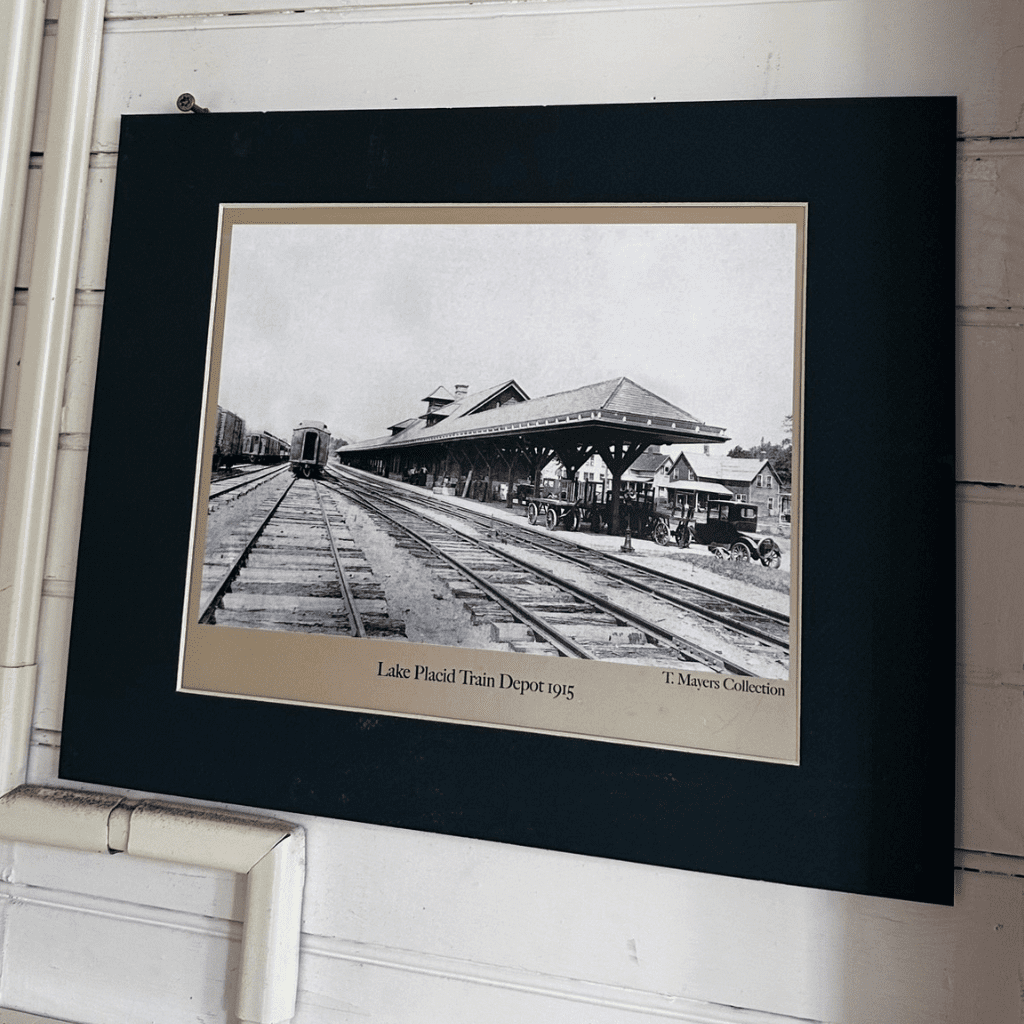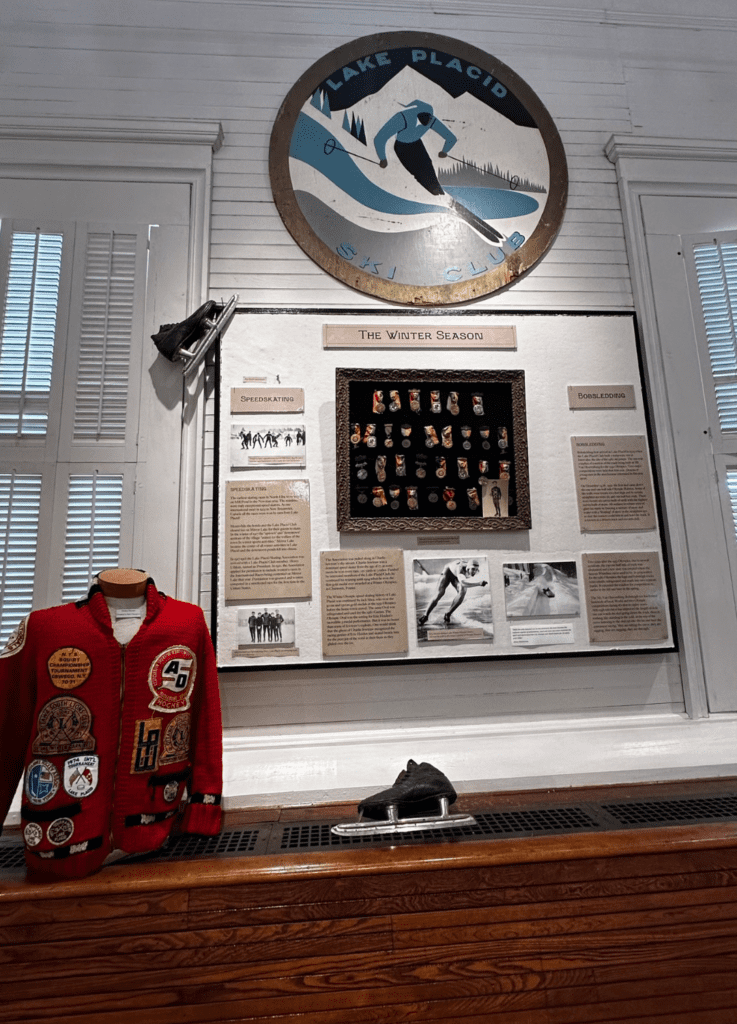Visit the Lake Placid History Museum
Read along as we visit the Lake Placid History Museum, then take a short drive over and explore for yourself!
About
In there own words, “The Lake Placid-North Elba Historical Society (the Society) is a membership organization created in 1948 for the purpose of documenting the history of the Village of Lake Placid and the Town of North Elba. In 1967 two patrons of the Society purchased the Train Station from the Penn Central Railroad Corporation, which had ceased both passenger and freight operations into Lake Placid. The Station was given to the Society in order to provide a permanent home for the organization as well as to create a museum. The Society is a 501C3 organization, and is chartered by the New York State Board of Regents.
Our mission is to preserve and present our community’s history in ways that are educational and enriching for residents and visitors.”
The Lake Placid History Museum is a short 4 minute drive (or 18 minute walk) from the Golden Arrow and is located on Station Street, just down from a local favrote, Lisa G’s. The museum is in an old train station and features a variety of old photos and artifacts from the early days in Lake Placid. The museum is split up by sections, which is how we will cover our visit below.
The Arts
The first thing you see when you walk in, is a wagon in the middle of the room – but more on that later!
The ticket booth is also straight ahead. Tickets are $5 for adults, $4 for seniors, and $3 for students. Children 10 and under are free. They also offer various levels of membership options that include free admission to the museum.
I went left from here and headed into “The Arts” room. It’s a small room, but has a collection of items from the Lake Placid Sinfonietta, a Chicago Cottage Organ, a Philco radio cabinet, and a Kate Smith display. For those who don’t know, Kate Smith was an American signer best known for her rendition of “God Bless America.” Her first visit to Lake Placid was in 1932 when she broadcast her radio show from the Lake Placid Club. Lake Placid became her summer home and she was active in the community for over 40 years.



Outside The Arts Room, near the Early Transportation exhibit, you can also find a section on Victor Herbert featuring his Victrola. Herbert was a composer, cellist, and conductor. He used the proceeds from one of his most well-known operettas “Babes in Toyland” to build Camp Joyland in Lake Placid in 1905.

Trains and Books and Things
Next, I went into another small room that featured their gift shop items. They have items like pint glasses, posters, postcards, books, and pins. This room also features information and photos about trains, fitting being in the train station! The first train arrived in Lake Placid on August, 1, 1893. This allowed for tourism to really take off in Lake Placid and the Adirondacks, and led to the building on many grand hotels. The train also brought mail, milk, and transported blocks of ice south.


Early Transportation
In the summers of the 1920s and 30s, the Friday night trains arrived in Lake Placid on Saturday mornings with 5 sections of sleeper cars bringing 350-400 passengers from Grand Central Terminal. Some of the nation’s wealthiest families of the time enjoyed the “sumptuous camps and lush Victorian hotels” of Lake Placid.
Other than information on trains in Lake Placid, the museum also has an old wagon, bicycles, and canoe. The first means of access to most of Placid Lake was by guide boats. Locals realized that providing transportation and guide services was a good source of income. Eventually steamboats came on the scene and circled the lake dropping of passengers, mail, and deliveries.
Before the Northway came into existence, trips to Lake Placid and the High Peaks tended to be leisurely affairs with many stops in the small hamlets of the Adirondacks. Since there was no television reception, the demand for entertainment was met with small “theme” parks. Lake Placid was home to two parks, one of which was Old MacDonald’s Farm. Here, kids got free straw hats and hay wagon rides. They could also visit animals and “feed” the bears. Many of the theme parks in the area eventually closed for various reasons, but you can still visit Santa’s Workshop in Wilmington.




Hotels
My favorite thing about my visit to the Lake Placid History Museum was all the old hotel photos.
By 1900, Lake Placid had seven large hotels: the Grandview Hotel, the Allen House, the Mirror Lake House, the Stevens House, the Lake Placid House, the Cascade House, and Castle Rusico.
Although most hotels were around Mirror Lake, a few were built on the shores of Placid Lake. Castle Rustico being the first. There was also Westside, which opened in 1882 and was renamed the Whiteface Inn in 1891, and the Ruisseaumont Hotel which was in operation from 1892 to 1909, when it was destroyed by fire.
Today, there is only one true hotel on Placid Lake, Lake Placid Lodge, although there are motels and hotels clustered around Paradox Bay.
There are many stories about the Grand Hotels, each hotel was special in its own way. Many were here for a short time; built by wood, heated by fireplaces, and lit by kerosene lanterns, most fell victim to fire. Some built later, of brick, like the Hotel Marcy (1927) and the St. Mortiz (1900) are still standing under different names (Grand Adirondack and The Pines, respectively). A few, such as the Cascade House and the Grandview, were torn down when they became obsolete.






Sports
Of course, a Lake Placid museum wouldn’t be complete without a section on sports!
There is a section on summer sports, with a feature on tennis, which was an incredibly popular sport from the 1880s on. Many camps on Lake Placid had private clay courts. Any hotel or guest house worth its name had at least one – The Lake Placid Club had 32!
There is also a section on winter sports. Did you know Lake Placid’s first winter sport was ice harness racing, dating back to the 1800s? At the turn of the century ice skating was a popular local sport and a boys’ hockey team was organized.
Outside you can also spot a display for NPT – New York State’s oldest long-distance trail. Completed in 1924, the Northville-Placid Trail (NPT) extends 138 miles through the Adirondack Park. The footpath connects hikers to the wild character of the Adirondack Park, as well as the communities that the trail crosses.
Purists think the ‘true’ north terminus of the trail is at the Lake Placid History Museum. The most updated guide book is less specific about its end terminus. It states that the trailhead on Averyville Road is the end of the hike “for all practical purposes”. The Museum welcomes the hiking community to stop by at any time, regardless of where you complete your hike!




The Lake Placid History Museum is open Memorial Day Weekend through Columbus Day weekend, Wednesday – Sunday. Visit their website for hours and more information. If you’re looking to kill a little time, visit the Lake Placid History Museum! You can also take part in their Historical Walking Tour!
More Blogs
45th Anniversary of the 1980 Winter Olympics
Celebrate the 45th Anniversary of the 1980 Winter Olympics! Photo...
Read MoreWhat to do on your 2024 holiday trip to Lake Placid
What to do on your 2024 holiday trip to Lake...
Read MoreThe only thing we overlook is the lake
Surrender yourself to the natural and untouched beauty of the Adirondack Mountains at the first resort in the U.S. to receive the Audubon International’s Platinum Eco Rating for Hotels. There are now only six hotels in the United States to obtain this honor! It’s a place to renew yourself on the serene shores of Mirror Lake, and take in the history of the town, just steps away from the famed Olympic Village and the heart of Lake Placid, New York. No other place on earth provides this unique blend of comfort, rejuvenation, or one-of-a-kind experiences. Start planning your stay at the Golden Arrow Lakeside Resort now!




